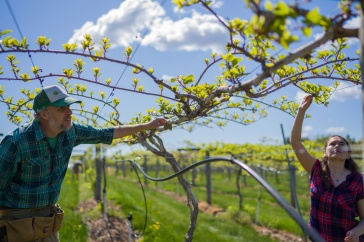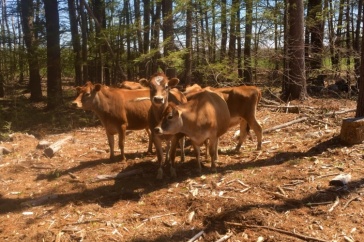
A study plantation of quinoa, lambsquarters and other weedy chenopods at UNH's Woodman Horticultural Research Farm

Researchers at the University of New Hampshire have launched a project that aims to “re-domesticate” the superfood quinoa in northern New England, giving the region’s farmers a new high-value grain crop that is in high demand in the nation and giving consumers a local source for the food.
The researchers are investigating the potential use of a wild/weedy, locally adapted Chenopodium species as a breeding partner with quinoa in an effort to make quinoa suitable for crop production under northern New England’s growing conditions. Their work is supported by the New Hampshire Agricultural Experiment Station.
“If we can successfully breed or re-domesticate a locally adapted quinoa variety that can be grown with commercial success, it would offer a new option to regional farmers interested in taking advantage of the current, very high price commanded by quinoa as a novel and highly nutritious grain crop,” says geneticist Tom Davis.
Erin Neff, a master’s student in integrative and organismal biology, is also working on the project.
According to the Food and Agricultural Organization of the United Nations, quinoa is a nutritional powerhouse that is high in protein, vitamins and fiber and low in fat. Quinoa is grown almost exclusively in South America. However, its potential for cultivation elsewhere is being widely explored.
Global production of quinoa has been increasing significantly, surpassing 228,000 metric tons in 2015, according to Statista. In 2014, the U.S. was the leading importer of quinoa in the world; U.S. quinoa imports totaled $159.12 million or about 68.9 million pounds. The global price of quinoa more than doubled from $2.96 per kilogram in 2010 to $6.74 per kilogram in 2014.
According to Davis, the plant genus Chenopodium includes the cultivated species, quinoa, and at least one problematic weed, lambsquarters, along with several other wild species in northern New England and about 150 wild species worldwide. So far, researchers have documented the existence of four wild/weedy Chenopodium species in northern New England, including the familiar lambsquarters.

One of these currently appears to be the most suitable breeding partner for quinoa. They also have confirmed that several existing, commercial quinoa varieties are challenging to grow successfully as a crop in Durham, New Hampshire, and that the fungal disease downy mildew is one of the quinoa production challenges to be overcome by breeding.
“Existing quinoa varieties are adapted to regions with less humid fall seasons, and do not mature well here. However, some of quinoa’s weedy relatives are very successful and well-adapted as weeds in northern New England,” Davis says. “It is always a challenge to ‘get to know’ a new species. We must learn how to grow the plants, how to perform genetic crosses, collect and germinate seed, differentiate among the wild species and so on. It takes considerable time and effort to learn by doing.”
This material is based upon work supported by the NH Agricultural Experiment Station, through joint funding of the National Institute of Food and Agriculture, U.S. Department of Agriculture, under award number 1006924, and the state of New Hampshire. This research also has been supported by the work of the Northern New England Collaborative Research Funding Program, a partnership of the Maine Agricultural and Forest Experiment Station, New Hampshire Agricultural Experiment Station and Vermont Agricultural Experiment Station.
-
Written By:
Lori Tyler Gula, PhD | NH Agricultural Experiment Station | lori.gula@unh.edu | 603-862-1452

















































